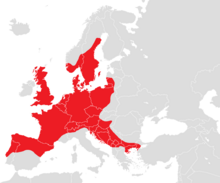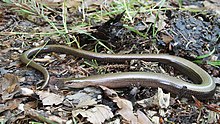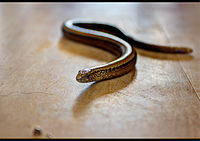Slow worm
| Slow worm | |
|---|---|

| |
| Scientific classification | |
| Domain: | Eukaryota |
| Kingdom: | Animalia |
| Phylum: | Chordata |
| Class: | Reptilia |
| Order: | Squamata |
| Family: | Anguidae |
| Genus: | Anguis |
| Species: | A. fragilis
|
| Binomial name | |
| Anguis fragilis | |

| |
| Range of A. fragilis | |
The slow worm (Anguis fragilis) is a reptile native to western
Slow worms are semifossorial[4] (burrowing) lizards, spending much of their time hiding underneath objects. The skin of slow worms is smooth with scales that do not overlap one another. Like many other lizards, they autotomize, meaning that they have the ability to shed their tails to escape predators. While the tail regrows, it does not reach its original length. In the UK, they are common in gardens and allotments, and can be encouraged to enter and help remove pest insects by placing black plastic or providing places to shelter such as piles of logs, corrugated iron sheets or under tiles.[5] On warm days, one or more slow worms can often be found underneath these heat collectors. One of the biggest causes of mortality in slow worms in suburban areas is the domestic cat, against which it has no defence.[6]
Slow worms have been shown to be a species complex, consisting of 5 distinct but similar species.
Taxonomy

Anguis fragilis was traditionally divided into two subspecies (A. f. fragilis and A. f. colchica), but they are now classified as separate species:[7][8]
- Anguis fragilis sensu stricto (found in western Europe, northern Europe and western Balkans) and
- Anguis colchica (found in eastern Europe, eastern Balkans and in western Asia).
Three more species were later distinguished from A. fragilis:
- Anguis graeca (found in southern Balkans) and
- Anguis veronensis (found on the Apennine Peninsula).
- Anguis cephalonica (native to the Peloponnese Peninsula)
Physical traits

Slow worms have an elongated body with a circular cross-section without limbs and reach a maximum length of up to 57.5 cm.
The skin surface consists of smooth, round-to-hexagonal scales which overlap like roof tiles and are roughly the same shape on the dorsal and ventral surfaces of the body. There are several longitudinal rows running along the underside. In total, the trunk has 125 to 150 transverse scale rows and the tail has another 130 to 160 rows. Under the scales there are bony plates (osteoderms), so that slow worms crawl much more stiffly and clumsily than snakes. The scaling of the head is similar to that of snakes. The ear openings are mostly completely hidden under the scales. The relatively small eyes have movable, closable eyelids (these are fused in snakes) and round pupils. The rather short tongue is broad, bilobed and does not end in fine tips. To lick, i.e. to absorb odorous substances, slow worms have to open their mouths slightly, as they lack the gap in the upper lip that snakes possess. The pointed, sometimes loosely fixed teeth are curved backwards; there are 7 to 9 teeth in the premaxilla, 10 to 12 in the maxilla and 14 to 16 in the lower jaw.[13]

Reproduction

In Central Europe, the mating season of the species is usually between late April and June. The males often wrestle violently around the females, although in most populations they are in the majority. The opponents try to push each other to the ground, bite each other and wrap themselves tightly around each other. When mating, the female is bitten in the head or neck region, while the male introduces his two hemipenes into the female's cloaca. Copulation can take several hours. Sometimes females mate with other males later. The gestation period of the females lasts 11 to 14 weeks, and subsequently, between mid-July and the end of August, and sometimes even later, they usually give birth to between eight and twelve young (extreme values: 2 to 28). Slow worms are ovoviviparous; at birth, the 7 to 10 cm long young animals are in a very thin, transparent egg shell, which they pierce immediately afterwards. They initially weigh less than a gram and still have a remnant of the yolk.[14] Juvenile slow worms have a contrasting color scheme and pattern. The top of the body is silvery-white to golden yellow, while the sides and underside are black.
Size and longevity
Adult slow worms grow to be about 50 cm (20") long, and are known for their exceptionally long lives; the slow worm may be the longest-living lizard, living about 30 years in the wild and up to at least 54 years in captivity (this record is held by a male slow worm that lived at the Copenhagen Zoo from 1892 until 1946, the age when first obtained is unknown).[15][16] The female often has a stripe along the spine and dark sides, while the male may have blue spots dorsally. Juveniles of both sexes are gold with dark brown bellies and sides with a dark stripe along the spine.
Predators
Predators of A. fragilis include
Ecology
These reptiles are largely nocturnal and do not bask in the sun like other reptiles, but choose to warm themselves indirectly underneath objects such as rocks which have been warmed by the sun. They can often be found in long
Protected status in the UK
In the United Kingdom, the slow worm has been granted
Ireland
The slow worm is assumed to be non-native in Ireland, possibly arriving in the 1900s. Due to their secretive habits they are difficult to observe and have only been sighted in parts of County Clare, mainly in the Burren region.[26][27][28]
Evolutionary history
Members of the genus
Gallery
-
A slow worm
-
A slow worm close
-
Slow worm in turquoise color
-
A slow worm moving through grass. This individual is a juvenile, as evinced by its golden colouration.
-
A slow worm seeks protection.
See also
- Glass snake
References
- . Retrieved 9 June 2022.
- ^ The "slow-" in slowworm is distinct from the English adjective slow ("not fast"); the word comes from Old English slāwyrm, where slā- means 'earthworm' or 'slowworm' and wyrm means "serpent, reptile". ("Slowworm". The American Heritage Dictionary of the English Language. Houghton Mifflin Harcourt. 2017.)
- ^ "Anguis fragilis". The Reptile Database. Retrieved 2021-04-07.
- ^ "Feeding state and selected body temperatures in the slow worm" (PDF). Herpetological Journal. 18: 59–62. 2008. Archived from the original (PDF) on 17 June 2009. Retrieved 2009-06-03.
- ^ Vernon, Jean (24 July 2019). "How can I help garden slow worms?". Richard Jackson Garden. Retrieved 26 July 2022.
- ^ a b "Slow worm | The Wildlife Trusts". www.wildlifetrusts.org. Retrieved 26 July 2022.
- ^ "Živa – Přehlížená rozmanitost slepýšů (Jiří Moravec, Václav Gvoždík)". ziva.avcr.cz. Retrieved 2021-03-24.
- PMID 20079858. Retrieved 1 April 2022.)
{{cite journal}}: CS1 maint: multiple names: authors list (link - ISSN 0946-7998, S. 117–118.
- ISBN 978-3-494-01581-1, S. 322–327.
- ^ Bryant SV, Bellairs ADA. 1967. Tail regeneration in the lizards Anguis fragilis and Lacerta dugesii. Zoological Journal of the Linnean Society 46 (310): 297-305.
- ^ Barr JI, Boisvert CA, Bateman PW. 2021. At what cost? Trade-offs and influences on energetic investment in tail regeneration in lizards following autotomy. Journal of Developmental Biology 9(4): 53.
- ISBN 3-437-35016-1, S. 617–631.
- ISBN 978-3-8001-4385-6, S. 619–632.
- ^ Smith, Malcolm (1951). "The British Amphibians and Reptiles". Archived from the original on 2017-09-16.
- ^ "Slow Worm".
- ^ Ornithology, British Trust for (2010-11-24). "Slow-worm". BTO - British Trust for Ornithology. Retrieved 2022-09-10.
- ^ "Slow Worm". surrey-arg.org.uk. Retrieved 2022-09-10.
- ^ "Slow-Worm". www.froglife.org. Retrieved 2022-09-10.
- ^ "Smooth snake | The Wildlife Trusts". www.wildlifetrusts.org. Retrieved 2022-09-10.
- ^ "Slow worms: Britain's most unusual lizards". www.nhm.ac.uk. Retrieved 2024-03-19.
- ^ Grace Bettayeb (16 March 2022). "Species in Focus: Slow Worm". iwt.ie. Irish Wildlife Trust. Retrieved 1 April 2022.
- S2CID 84703263.
- ^ "BBC - Science & Nature - Wildfacts - Slow worm". BBC. Archived from the original on 4 May 2007. Retrieved 2007-05-16.
- ^ "Wildlife and Countryside Act 1981". Legislation.gov.uk. Retrieved 20 September 2015.
- ^ Grace Bettayeb (16 March 2022). "Species in Focus: Slow Worm". iwt.ie. Irish Wildlife Trust. Retrieved 1 April 2022.
- ^ "Archived copy" (PDF). Archived from the original (PDF) on 2014-02-03. Retrieved 2014-01-25.
{{cite web}}: CS1 maint: archived copy as title (link) - ^ Dick Warner (18 March 2013). "Slow worm makes its entrance". irishexaminer.com. Irish Examiner. Retrieved 31 March 2022.
- S2CID 128651937.
- ISSN 1664-2384.
External links
 Media related to Anguis fragilis at Wikimedia Commons
Media related to Anguis fragilis at Wikimedia Commons





